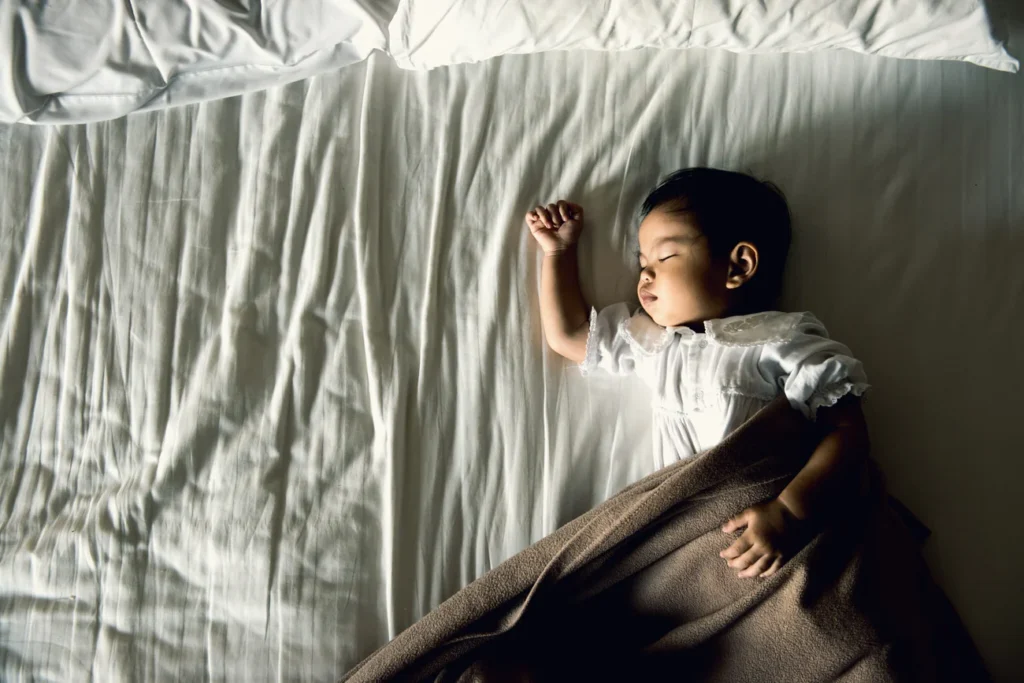The Power of Light and Sleep for Babies
Sunlight is nature’s gift to establishing a healthy sleep-wake pattern. Exposing your baby to natural light during the day helps set their internal clock and makes it easier for them to distinguish between day and night.
1. Morning light
In the morning, take your baby outside for a walk for at least 30 minutes. This exposure to bright morning light helps signal the start of the day and triggers the release of cortisol, promoting your baby’s alertness and sleep-wake cycle.
2. Afternoon and Daytime Naps
Your baby will nap longest in the dark. If they are sleeping so much during the day that they aren’t sleeping enough at night, try adding light to the room where your baby naps. This will reinforce stronger circadian rhythms and encourage sleeping through the night faster.
3. Limit Blue Light at Night
As the evening approaches, minimize exposure to artificial light, especially from screens. Blue light and artificial light suppress melatonin which will make it harder for your baby to fall asleep. It can disrupt their circadian rhythm development, leading to serious health issues in the future. If your baby needs some sort of light to help them sleep at night, opt for an amber or red light that emits no blue light hues like SKYVIEW™. SKYVIEW’s sleep mode doesn’t suppress melatonin, which can help your baby wind down and prepare them for a restful night’s sleep.
4. Bringing Outdoor Light In
Natural light isn’t always available in everyone’s home, and we don’t always have the time to take walks during the day. Adding a SKYVIEW™ to your baby’s routine can help create that ideal sleep schedule because unlike standard indoor lighting and color-tuning lights, SKYVIEW™ works on a biological level. SKYVIEW’s light shifts throughout the day to target the melanopsin in the eye that helps regulate the body’s internal clock.

Creating a Calming Bedtime Routine
A consistent bedtime routine is crucial for babies to understand that it’s time to wind down and prepare for sleep. While light exposure helps during the day, you should focus on creating a soothing atmosphere before bedtime.
1. Light
So, what’s the best color light to help your baby sleep? Long story short, color is only part of the picture, it’s about spectrum as well. Yes, warm amber or red lights are preferred colors for sleep, however, color-tuning lights don’t consider the invisible wavelengths that can keep your baby up at night. Standard lighting, even color-tuning lights, were designed for the home and not biology. Our bodies can’t tell the difference between daytime and night with these lights. They put out wavelengths that are too long in the evening for our bodies to recognize it’s nighttime. That’s why SKYVIEW™ is one-of-a-kind, it puts out wavelengths that fluctuate and mimics what natural light does throughout the day, so you’re always getting the right light at the right time.
2. Calm Activities
Engage your baby in quiet and relaxing activities before bedtime, such as reading a story or singing lullabies. This promotes a sense of security and comfort, easing the transition to sleep.
3. Consistency is Key
Stick to the same bedtime routine every night. Repetition helps babies anticipate what’s coming next, making them feel more secure and ready for slumber.
By understanding the influence of light and the circadian rhythm on your baby’s sleep, you can help get them on a sleep schedule for optimal health. Babies are adaptable, but it’s normal for them to have occasional sleep disruptions due to growth spurts or teething. Stay consistent with your efforts, and you’ll gradually see improvements in their sleep patterns.






